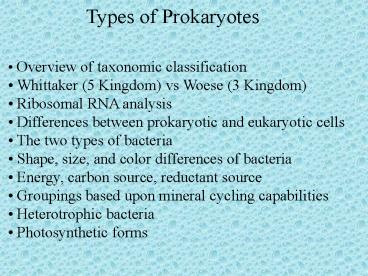Types of Prokaryotes PowerPoint PPT Presentation
1 / 15
Title: Types of Prokaryotes
1
Types of Prokaryotes
- Overview of taxonomic classification
- Whittaker (5 Kingdom) vs Woese (3 Kingdom)
- Ribosomal RNA analysis
- Differences between prokaryotic and eukaryotic
cells - The two types of bacteria
- Shape, size, and color differences of bacteria
- Energy, carbon source, reductant source
- Groupings based upon mineral cycling
capabilities - Heterotrophic bacteria
- Photosynthetic forms
2
Overview of Taxonomic Classification
Carolus Linnaeus (1707 - 1778) was the first to
establish the hierarchical classification system
that we use to classify life forms. The number
of major categories (Kingdoms) as well as the
divisions of organisms between these higher and
lower categories have changed over time. We are
presently still using the 5 kingdom
classification system of Whittaker (1924 - 1980)
although recent analysis of rRNA (Woese) has
revealed that life more logically be placed into
3 major categories.
3
Fungi
Animalia
Plantae
Protista
Monera
4
(No Transcript)
5
Ribosomal RNA Analysis
Useful molecules for inferring phylogeny are
sometimes considered Evolutionary
Chronometers To be considered a good
chronometer 1. A molecule has to be
universally distributed across the groups
chosen for study. 2. It must be identical in
function. 3. It is important to align the two
molecules in order to identify regions of
sequence homology and sequence heterogeneity.
4. The sequence of the molecule chosen should
change at a rate commensurate with the
evolutionary distance being estimated (i.e., in
should be informative).
6
Differences Between Prokaryotic and Eukaryotic
Cells
7
(No Transcript)
8
(No Transcript)
9
Broad Comparisons Between Domain Types
10
Shape, Size, and Color Differences of Bacteria
- Shapes include
- Spheres called cocci (greek berry)
- Cylinders called rods or bacilli (Latin
bacillus walking stick) - Spiral or spirilli (Greek spirillum
little coil)
11
- Size range of bacteria are from
- 0.2 microns to 750 microns
- Mycoplasma sp. Thiomargarita
namibiensis (Discovered in 1999) - But bacteria are generally small compared to
eukaryotes which has some important advantages. - Nutrients and wastes are transported in and out
the cell via the cytoplasmic membrane. - The rate of transport determines the metabolic
rates and therefore the growth rates of microbial
cells - The smaller the size, the larger the surface area
of the cytoplasmic membrane to volume and
therefore the faster is it's potential growth
rate. - Color of bacteria as promoted by pigments and
inclusionary bodies can be highly variable (i.e.
Green purple sulfur bacteria).
12
Bacterial Types Based Upon Energy, Carbon Source,
Reductant Source
Nutritional Type Energy Carbon
Examples Source
Source
Cyanobacteria, Photoautotrophs Light
CO2 some Purple
and Green
Bacteria
Some
Purple Photoheterotrophs Light Organic
and Green
compounds Bacteria
Inorganic Chemoautotrophs or compounds,
A few Bacteria Lithotrophs
(H2,NH3,NO2,H2S) CO2 and
many (Lithoautotrophs)
Archaea Chemoheterotrophs Organic
Organic Most Bacteria, or Heterotrophs
compounds compounds some Archaea
13
Groupings Based Upon Major Metabolic Capabilities
Carbon
1) Respiration (All aerobes) 2) Fermentation 3)
Methanogenisis 4) Assimilative carbon reduction
Nitrogen
1) Nitrogen fixation 2) Denitrification 3)
Nitrification 4) Nitrogen remineralization 5)
Inorganic nitrogen uptake
Sulfur
1) Assimilative sulfur reduction 2) Dissimilative
sulfate reduction 3) Chemotrophic sulfur
oxidations
14
Heterotrophic Bacteria
- Vast majority of planktonic bacteria are aerobic
- heterotrophs
- Most are gram negative
- Most can use NO3 or SO4 as terminal electron
acceptors - in respiration
- Important roles include nutrient and organic
matter - uptake, nutrient remineralization, carbon
- transformation, and food web constituent
- Main benefactors of marine primary production
- Most globally abundant type of bacteria
- - x 107 ml-1 (Estaries)
- - x 104 ml-1 (Open Ocean)
- - x 109 ml-1 (Sediments)
15
Photosynthetic Bacteria
- Green and Purple Sulfur Bacteria
- Anerobic, Sediment associated
- Some are photoheterotrophic
- Anoxygenic, with Bacteriachlorophyll
- None use H2O as reductant source
- Cyanobacteria
- 4 morphotypes (Solidary, Capsular, Filamentous,
- Filamentous with specialized cells)
- Very Eurytopic
- Some can still use H2S as reductant source
- Nitrogen Fixers
- Some Toxic Forms
- Many Bloom Formers

